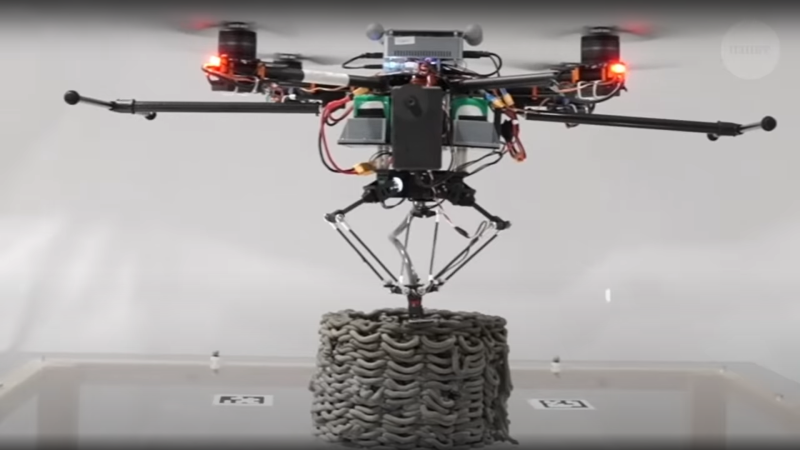Even in technical disciplines such as engineering, there is much we can still learn from nature. After all, the endless experimentation and trials of life give rise to some of the most elegant solutions to problems. With that in mind, a large team of researchers took inspiration from the humble (if rather annoying) wasp, specifically its nest-building skills. The idea was to explore 3D printing of structures without the constraints of a framed machine, by mounting an extruder onto a drone.
As you might expect, one of the most obvious issues with this attempt is the tendency of the drone’s to drift around slightly. The solution the team came up with was to mount the effector onto a delta bot carrier hanging from the bottom of the drone, allowing it to compensate for its measured movement and cancel out the majority of the positional error.
 The printing method relies upon the use of two kinds of drone. The first done operates as a scanner, measuring the print surface and any printing already completed. The second drone then approaches and lays down a single layer, before they swap places and repeat until the structure is complete.
The printing method relies upon the use of two kinds of drone. The first done operates as a scanner, measuring the print surface and any printing already completed. The second drone then approaches and lays down a single layer, before they swap places and repeat until the structure is complete.
Multiple drones can print simultaneously, by flying in formation. Prints were demonstrated using a custom cement-like material, as well as what appeared to be expanding foam, which was impressive feat to say the least.
The goal is to enable the printing of large, complex shaped structures, on any surface, using a swarm of drones, each depositing whatever material is required. It’s a bit like a swarm of wasps building a nest, into whatever little nook they come across, but on the wing.
We’ve been promised 3D printed buildings for some time now, and while we’re not sure this research is going to bring us any closer to living in an extruded house, we’re suckers for a good drone swarm here at Hackaday.
Thanks to [Zane] for the tip!
















Having a wasp to build your house is probably going to happen sooner than this.
When are the graffiti artists going to use drones to paint water towers?
I have literally had this conversation with someone recently!🤣
I’ve had this thought a few years ago. Billboards first, non destructive. Devil horns etc. on political ads.
I’ll say from personal experience that it’s not too hard to add marking capability to drones and when you have autonomous operation, well, the sky’s the limit.
Pretty sure it’s happened. Also seen things like this for doing graffiti: https://www.instructables.com/XY-Plotter-Drawing-Robot-Arduino-Polargraph/
…Probably works better because it’s easier to get the ideal distance from the nozzle to the canvas without breaking propellers. And the wind isn’t gonna deflect the stream and wash paint all over the place
Very impressive, but can these systems also prints with disabled cooling fans?
They seem to be not very sure if they are meaning accuracy or precision in the video :P https://hackaday.com/2021/03/20/machinists-precision-vs-woodworkers-precision/
To me it would sound immensely more sane to have a drone drop down a 3D-printer then occasionally add new supplies (power + printing material) and/or move the printer than to continuously have a drone flying over the printed area.
> After all, the endless experimentation and trials of life give rise to some of the most elegant solutions to problems.
Nature also gave rise to the design of the human knee and the human ability to block our air supply by swallowing too big of a bit of food.
Not every problem needs to be solved by drones, or 3d printing, or a combination of the two.
Throw some AI and bitcoin on it and you’ve got fantastic VC bait… maybe some laughable contrivance that it’s eco-friendly? Despite using awful materials and enormous amounts of energy of course, don’t worry about it we put a leaf sticker on there
Oh lol I didn’t watch the video until now and of course they do shoehorn in the obligatory evidence-free claim of it being environmentally superior. Everyone has to do this now
Agree there’s a lot of greenwashing going on everywhere. I don’t think “3D printing” is the greenest way to build a house, much like the fad of Blockchain for everything a few years back. In this case it’s not hard to imagine how it might be more environmentally friendly than say a gas powered digger/cement mixer or transporting concrete blocks from 1000kms away. But there are greener ways to do things. I think the best use case here is having the ability to erect some temporary housing for disaster relief quickly and easily, but again, there are currently better and more efficient methods already established compared to how this works.
Mud dauber wasps